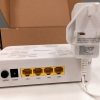Ofcom UK Explores Hybrid Sharing of 6GHz for Wi-Fi and Mobile

The UK telecoms regulator, Ofcom, has today proposed an alternative way of solving the debate over whether WiFi or mobile broadband (5G) should benefit from the extra capacity (i.e. faster speeds) available in the Upper 6GHz radio spectrum band (6425 to 7125MHz) – “hybrid sharing“.
Just to recap. Ofcom has already made the Lower part (5925 to 6425MHz) of this band available for WiFi under the new WiFi 6E and future standards (here), but the Upper part has remained the subject of some debate. Mobile operators want to harness it (licensed) to deliver faster 5G based mobile speeds, while others say it should go toward licence-exempt consumer WiFi.
So far, the regulator has tended to favour a “no change” approach (here), at least until such time as the natural market direction changes or the wider industry adopts a clear position at the next World Radiocommunications Conference (WRC) – due to be held between 20th November and 15th December 2023.
Advertisement
However, rather than choosing between the two, Ofcom has today announced that they’re considering a third approach (here) that would enable the use of both Wi-Fi and mobile in the Upper 6GHz band. The regulator calls this method “hybrid sharing“.
Two Examples of Hybrid Sharing
Indoor outdoor split.
Wi-Fi routers tend to be indoors – carrying broadband traffic within a localised indoor area; whereas mobile transmitters are mostly located outdoors – providing wider area coverage. So, we are exploring the possibility of enabling the indoor use of Wi-Fi while also enabling licensed mobile use outdoors.
Geographical sharing.
Most of the data traffic carried across mobile networks tends to be concentrated in a relatively small proportion of sites. It might be possible to enable licensed mobile use in specific high-traffic locations while allowing Wi-Fi use elsewhere. It might also be possible to prioritise Wi-Fi use in specific areas of high demand while allowing mobile use in other areas.
As ever, the big difficulty with this sort of approach is the need to achieve co-existence without causing interference for one service or the other, which has historically been easier said than done. Personally, we tend to favour simplicity over complexity in these things, as complexity tends to add costs and other problems (e.g. see White Space broadband technologies for an example).
Ofcom’s consultation is thus looking to identify an appropriate hybrid sharing mechanism to facilitate coexistence between the services, as well as to encourage the development of technology-based solutions (e.g. managed databases and enhanced dynamic sensing) and pressing for international harmonisation to support such an approach (also needed for economies of scale for equipment).
As we’ve said, this is not an easy thing to get right. For example, Ofcom talks a lot about Wi-Fi being an indoor technology, although even home signals extend outdoors for a distance and that’s before we get into the issue of public WiFi hotspots and related Smartphone connectivity.
Advertisement
The regulator intends to consult on all this until 15th September 2023 and added that their “work with other European administrations to develop harmonised hybrid sharing mechanisms will continue after WRC-23, regardless of the outcome of WRC-23 on agenda item 1.2“.
Mark is a professional technology writer, IT consultant and computer engineer from Dorset (England), he also founded ISPreview in 1999 and enjoys analysing the latest telecoms and broadband developments. Find me on X (Twitter), Mastodon, Facebook, BlueSky, Threads.net and Linkedin.
« 85% of UK People Haven’t Heard of Alternative Broadband Networks






















































Cake and eat it. Is this simply the case OFCOM realise it would be better to go licence free and improve Wi-Fi, but also don’t want to loose the opportunity to sell it?
I can’t see how you can “share” it. Mobile phones are often used inside as well, so that brings interference to Wi-Fi using the same frequencies.
You can go down the route of the Wi-Fi device listening for licensed usage in the same way they do for radar on the 5GHz bands, and then the access point turns of the frequencies or shifts them away, but that comes with a lot of reliability issues with Wi-Fi, so you have people buying new kit, only to find they can’t use the extra frequencies and have wasted their money, or it works one day then doesn’t work the next.
If you do it by location, that means Wi-Fi access points will need GPS in them and some means of downloading a database of locations where to use or not use these frequencies (the same as they do with some Femtocells). This adds costs to the access point, extra complexities and moving goal posts.
Ofcom should be considering hybrid spectrum sharing in the 5925 – 6425 MHz band, rather than the 6425 – 7125 MHz band. A geolocational database for the lower 6GHz band (such as the AFC system used in the US) would permit higher powers for unlicensed use; without adding unnecessary complexity to yet another 5G band.
The regulator intends to consult on all this until 15th September 2023, but have already made up their mind, but they just have this consultation to make it look like people have a say.
That is what consultations is all about.
Called lack of trust,
This is standard. Most of us aren’t even remotely qualified to give an educated opinion on RF spectrum. Ofcom consult with experts to form the proposals in a closed forum and then run those proposals past the public.
Nothing to do with trust, everything to do with that we, the public, don’t as a whole have the knowledge, skills and experience to offer input of any value into forming the proposal. Now it’s there the bar to comment on it is lower. Some responses will be the uneducated on their soapbox, the odd one might be from an expert not involved in the proposal formulation and give some good points to be considered.
This is never ending. The Mobile Network Operators want more and more. DTTV/Freeview had already been push down the bands twice. The MNOs have 700mhz, 800, 900, 1400, 1800, 2100, 2400, 2600, 3800mhz blocks. We need to give more capacity to home networks so we have reliable capacity & more bands for future proofing.